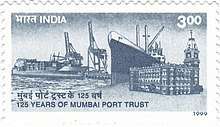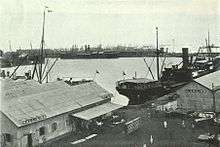Mumbai Port Trust
Mumbai Port Trust (also known as the Bombay Port Trust) is a port which lies midway on the West coast of India, on the natural deep-water harbour of Mumbai (Bombay) in Maharashtra. It is the largest port in india by size and traffic .The harbour spread over 400 square kilometres (150 sq mi) is protected by the mainland of Konkan to its east and north and by the island city of Mumbai to its west.[1] The harbour opens to the south to the Arabian Sea.
| Mumbai Port Trust Bombay Port Trust | |
|---|---|
Logo of Mumbai Port trust | |
| Location | |
| Country | India |
| Location | Mumbai, Maharashtra |
| Coordinates | 18°56.3′N 72°45.9′E[1] |
| Details | |
| Operated by | Mumbai Port Trust |
| Owned by | Government of India |
| Available berths | 63[2] |
| Wharfs | 5 |
| Employees | 7000 [3] |
| Statistics | |
| Annual cargo tonnage | 62.82 million tonnes (2017–18)[4][1] |
| Annual container volume | 118,000 TEU (2007–08) |
| Website mumbaiport | |
The port is administered by the Mumbai Port Trust (MbPT, formerly the Bombay Port Trust (BPT)), an autonomous corporation wholly owned by the Government of India.[5] The port is primarily used for bulk cargo, while most container traffic is directed to Nhava Sheva port across the harbour.
History


Mumbai Harbour has been used by ships and boats for centuries. It was used by the Maratha Navy, as well as the British and Portuguese colonial navies. In 1652, the Surat Council of the East India Company, realising the geographical advantage of the Port, urged its purchase from the Portuguese. Their wish was gratified nine years later when, under the Marriage Treaty between Charles II of Great Britain and the Infant Catherine of Portugal, the ‘Port and Island of Mumbai’ were transferred to the king of Great Britain The first of the present-day docks of the Mumbai Port were built in the 1870s.[1] Bombay Port Trust (BPT) was established as a corporation on 26 June 1873.[6] BPT's founding chairman was Colonel J.A. Ballard.
Port development was undertaken by the civil engineering partnership Sir John Wolfe-Barry and Lt Col Arthur John Barry as Joint Consulting Engineers to the Bombay Port Trust at the end of the nineteenth century.[7]
From its establishment, the port has been the gateway to India, and was a primary factor in the emergence of Mumbai as the commercial capital of India. The port and the corporation took their present names in the 1990s.
Over the decades, the port underwent tremendous expansion, with the addition of berths and cargo handling capacities. However, Mumbai's expanding growth and population pressure constrained the growth of the port by the 1970s. This led to the establishment of the Nhava Sheva port across Mumbai Harbour in Navi Mumbai on the Konkan mainland. Nhava Sheva began operations in 1989, and most container traffic now flows through Nhava Sheva.
Facilities
Mumbai Port has three enclosed wet docks. Prince's Dock was commissioned in 1880. As of 2008, it has 8 berths with a minimum draft of 6.9 metres (23 ft). Victoria Dock, commissioned in 1891, had 14 berths as of 2008 with a minimum draft of 6.7 metres (22 ft). Indira Dock, commissioned in 1914, had 21 berths, with a minimum draft of 7.0 metres (23.0 ft). Prince's Dock and Victoria Dock are semi-tidal docks, with vessels docking and departing at high tide. Indira Dock has a lock, enabling vessels to enter or depart at any time.[2]
The port has four jetties on Jawahar Dweep, an island in the harbour, for handling Crude and petroleum products. These jetties have a draft of 12.2 metres (40 ft). Liquid chemicals are handled from a jetty on Pirpau.
Ballard Pier Extension has a passenger terminal, including immigration clearance facilities for crews and passengers of cruise liners.
The port has a total of 69 anchorage points. A pilot is mandatory for all vessels of over 100 tonnes net weightage.[8]
See also
- Chhatrapati Shivaji Maharaj International Airport
- Nhava Sheva Port
References
- "Port Profile". Mumbai Port Trust. Archived from the original on 25 August 2011. Retrieved 23 September 2011.
- "Port Layout". Mumbai Port Trust. Archived from the original on 25 August 2011. Retrieved 23 September 2011.
- Srinath Rao (16 January 2018). "Since early January: In a first, Mumbai Port Trust operational for 24 hours". Indian Express.
- "Cargo traffic handled by major ports up 4.77% in FY18". ndia Times. 8 April 2018.
- "Administration". Mumbai Port Trust. Archived from the original on 17 February 2012. Retrieved 23 September 2011.
- Mumbai Port Trust is 125. Indian Express. 26 June 1997. Archived 9 June 2009 at the Wayback Machine
- Frederick Arthur Crisp (1906) Visitation of England and Wales, Volume 14, London.
- Facilities. mumbaiport.gov.in Archived 27 February 2009 at the Wayback Machine